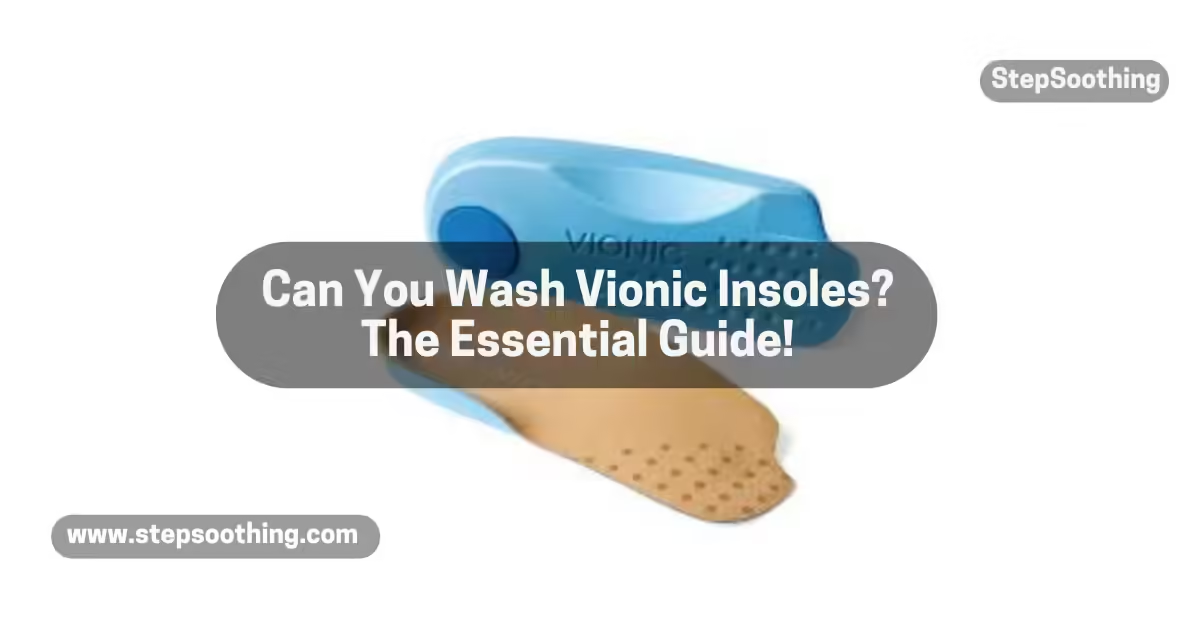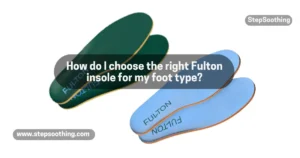“Wondering if you can wash your Vionic insoles? Good news—you absolutely can!” Vionic insoles, known for their therapeutic design and exceptional comfort, are a game-changer for people seeking reliable foot support. But like any daily-wear product, they can accumulate dirt, odor, and sweat over time, impacting both their hygiene and longevity. In this article, we’ll guide you on how to clean Vionic insoles effectively to keep them fresh, extend their lifespan, and maintain peak comfort and support. Whether you’re dealing with odors or just want to keep your insoles in top shape, we’ve got you covered with every step.
Understanding Vionic Insoles

What Are Vionic Insoles?
Vionic insoles are specially engineered footbeds designed to provide optimal support and comfort. They feature a deep heel cup and cushioned materials that help realign the feet and reduce excessive pronation, making them ideal for those with flat feet or foot pain. Their unique design offers a blend of cushioning and stability, ensuring your feet stay comfortable throughout the day.
Why Care for Your Insoles?
Proper care and maintenance of your Vionic insoles are crucial for several reasons. First, hygiene plays a significant role; as you wear your shoes, your feet sweat, leading to bacteria buildup and unpleasant odors. Keeping your insoles clean not only improves foot hygiene but also enhances their performance. A well-maintained insole will provide better support and comfort, extending its lifespan.
Vionic insoles have gained popularity among those seeking comfort and support for their feet. With their innovative design and therapeutic benefits, they help alleviate various foot ailments. However, as with any footwear, they can accumulate dirt, sweat, and odors over time. This begs the question: Can Vionic insoles be washed? The answer is yes! In this article, we’ll explore how to effectively clean your Vionic insoles, why it’s essential, and how to maintain their longevity.
When and Why to Clean Your Vionic Insoles
Signs Your Insoles Need Cleaning
It’s essential to recognize when your insoles require a good wash. Some signs to look out for include:
- Odors: If your insoles start to smell, it’s time for a cleaning.
- Moisture Buildup: Excessive moisture can lead to bacteria growth.
- Visible Dirt: Any dirt or grime is a clear indicator that your insoles need attention.
Benefits of Regular Cleaning
Cleaning your Vionic insoles offers several benefits:
Extended Lifespan: Regular cleaning can prevent wear and tear, allowing your insoles to last longer.
Enhanced Comfort: A clean insole will feel fresher and provide better support.

Step-by-Step Guide to Washing Vionic Insoles
Keeping your Vionic insoles clean is essential for their performance and your foot health. This guide will help you through the process, ensuring your insoles stay fresh, supportive, and odor-free.
Step 1: Understanding the Importance of Cleanliness
As we wear our shoes throughout the day, our feet sweat, leading to the accumulation of bacteria and unpleasant odors. Proper hygiene is vital to maintaining the longevity and functionality of Vionic insoles, ensuring they continue to provide optimal support and comfort.
Step 2: Manufacturer Instructions
Vionic provides specific guidelines for washing their insoles. While the cleaning method may vary slightly depending on the type of insole, most can be safely washed to refresh them and eliminate bacteria. Always refer to the manufacturer’s instructions for your specific insole model.
Step 3: Benefits of Washing Vionic Insoles
Washing your Vionic insoles offers several benefits:
- Eliminates Dirt and Odor: Regular washing removes sweat, dirt, and odors, restoring your insoles to their original cleanliness.
- Prevents Bacteria Growth: Keeping your insoles clean helps prevent the growth of bacteria that can cause foot-related issues.
- Revives Cushioning: Washing can restore the insoles’ cushioning properties, ensuring long-lasting comfort and support.
Step 4: Gather Your Cleaning Supplies
Before starting the cleaning process, gather the necessary materials:
- Mild detergent (suitable for delicate fabrics)
- Soft brush or cloth
- Basin for washing
- Clean towels for drying
Step 5: Remove Insoles from Shoes
Begin by carefully taking the Vionic insoles out of your shoes. This step allows for a more thorough cleaning process and ensures that no dirt or bacteria are transferred back into the shoes.
Step 6: Decide on Washing Method
You can wash your Vionic insoles either by hand or in the washing machine.
- Hand Washing: This method is generally safer and allows for more control.
- Machine Washing: If you choose this method, use a gentle cycle to protect the insoles.
Step 7: Choose the Right Detergent
When washing your insoles:
- Hand Washing: Use a mild detergent designed for delicate fabrics. Avoid harsh chemicals or bleach, as they can damage the insoles.
- Machine Washing: Again, choose a gentle cycle with a mild detergent.
Step 8: Cleaning the Insoles
For Hand Washing:
- Fill a Basin: Use lukewarm water and add a small amount of your chosen detergent.
- Agitate: Gently stir the water to create suds.
- Scrub: Place the insoles in the basin and use a soft brush or cloth to scrub away dirt and odors, focusing on any particularly dirty areas.
For Machine Washing:
- Place in a Mesh Bag: If using a washing machine, put the insoles in a mesh laundry bag to protect them.
- Wash: Set the machine to a gentle cycle with mild detergent.
Step 9: Rinse the Insoles
After washing, thoroughly rinse the insoles with clean water to remove any soap residue. It’s crucial to ensure that all detergent is washed out, as any remaining soap can lead to irritation.
Step 10: Drying the Insoles
- Gently Squeeze: After rinsing, carefully squeeze out excess water without twisting or wringing the insoles, as this could distort their shape.
- Lay Flat to Dry: Place the insoles between clean towels to absorb moisture. Avoid direct sunlight or heat sources, as they can damage the materials. Air drying is the safest option to maintain their shape and functionality.
Step 11: Reinserting the Insoles
Once the insoles are completely dry, reinsert them back into your shoes. Make sure they fit properly and lie flat to ensure optimal comfort and support.

Regular Maintenance Tips
To keep your insoles in great shape between washes:
Proper Storage: Ensure insoles are completely dry before storing them. Store them in a cool, dry place to minimize bacteria growth.
Air Out After Use: After wearing your shoes, remove the insoles and let them air out to reduce moisture and odor buildup.
Odor Control: Use baking soda or a vinegar solution to keep odors at bay. Sprinkling baking soda on the insoles or mixing equal parts water and vinegar can effectively eliminate odors and bacteria.
Best Practices for Washing Vionic Insoles
To ensure the longevity and effectiveness of your Vionic insoles, here are some best practices to follow when washing them:
- Read and adhere to the manufacturer’s guidelines specific to your insole type.
- If using a washing machine, opt for a gentle cycle to prevent excessive friction.
- Avoid using hot water when cleaning, as it may distort the structure of the insoles.
- Harsh chemicals and bleach can damage the insoles, so it’s best to avoid them.
- While machine drying may be convenient, air drying is gentler on the insoles and helps maintain their shape.
Final Thoughts
To ensure your Vionic insoles provide long-lasting support and comfort, regular cleaning and careful maintenance are essential. Here’s a summary of key practices for maintaining insole hygiene and durability:
- Preserve Hygiene: Regularly washing your Vionic insoles prevents bacteria and odor buildup, ensuring better foot health.
- Extend Lifespan: By following proper care and maintenance of insoles, including air drying and avoiding direct sunlight, you can maximize their longevity and cushioning.
- Enhanced Comfort and Support: Regular care keeps insoles effective, alleviating issues like foot discomfort and back pain, which ensures that they remain beneficial over time.
- Proper Cleaning: Clean with mild detergent, and always air dry rather than using heat to maintain structural integrity. This method is also suitable for other brands.
- Routine Checks: Inspect insoles frequently for wear. Replacing or reinforcing them as needed ensures they continue to support you effectively, avoiding issues like how to fix worn out insoles.
By following these steps, your Vionic insoles will continue to provide optimal support, helping to enhance comfort, improve foot hygiene, and extend their useful life.
People Also Asked
Can I use soap to wash Vionic insoles?
Yes, you can use a mild detergent or soap specifically designed for delicate fabrics to wash Vionic insoles effectively.
Can I put Vionic insoles in the dryer?
While machine drying is generally not recommended, you can dry Vionic insoles in the dryer on a low heat or air-only setting. However, air drying is the most gentle and preferred method.
How often should I wash Vionic insoles?
The frequency of washing Vionic insoles depends on personal preference and usage. As a general guideline, washing them every few weeks or when they start to show signs of dirt or odor is recommended.
Do I need to remove the insoles before washing the shoes?
For effective cleaning, it is advisable to remove the insoles from the shoes before washing them. This allows you to clean the insoles more thoroughly and maintain the hygiene of both the insoles and the shoes.
Can I use bleach to clean Vionic insoles?
No, it is not recommended to use bleach on Vionic insoles. Bleach can damage the insoles and compromise their integrity. Stick to mild detergents and gentle cleaning methods instead.
In conclusion, keeping your Vionic insoles clean is vital for hygiene and extended comfort. With proper care and regular washing following the manufacturer’s guidelines, you can maintain their performance and ensure your feet are supported and comfortable with every step.



